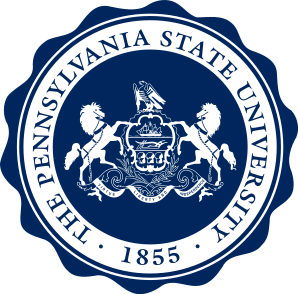Couple’s inaugural gift for Steidle laboratory honors 1942 alumnus
UNIVERSITY PARK, PA (October 3, 2014) – In 1942, Paul Reed graduated from Penn State with a bachelor’s degree in ceramic science. Forty years later, in 1982, his son Joel Reed did the same. As undergraduates, both father and son spent countless hours in the historic Steidle Building, which is the long-time home to the Department of Materials Science and Engineering in the College of Earth and Mineral Sciences (EMS). Nestled between Willard and Hosler buildings near West Halls, Steidle Building is currently undergoing a transformative, three-year renovation to bring the facility into the 21st century.
Joel and his wife, Kim Boeshore Reed, recently made a philanthropic commitment to name one of the new laboratories the Paul Herman Reed Thermal Characterization Laboratory in honor of Joel’s father. The Reeds’ gift is both the inaugural commitment to name a space in the Steidle Building and a tribute to their family legacy at Penn State.
“While Kim and I have donated to Penn State and EMS for years, we had always planned to make a more sizable contribution to the college at some future time,” said Joel Reed. “The Steidle renovation has provided a unique opportunity to support the college and provide a permanent legacy in honor of someone we love.”
The story of the Edward Steidle building has always been one of transition. Established as the Mineral Industries Building in 1929, it was later dedicated to the former dean of EMS, Edward Steidle. It was the forward-looking Steidle who saw a need to expand the purview of what was then the School of Mines and Metallurgy to encompass a larger, technologically advanced curriculum. While the building has served the needs of the department for many years, the time has come to update. In order to operate a technologically advanced, competitive department, further renovation and modernization is required beyond what is feasible within the confines of the current footprint.
Steidle Renovation
A plan for the Steidle Building renovation was created to retain the character of the current building, while completely re-imagining the interior structure. A glass atrium will be built in place of the 1939 partial addition, spanning the width of what was once the interior courtyard. This new addition will house expansive lab space, and re-orient the main entrance of the building to what is currently the basement level at the rear of the structure. The new open concept design will be anchored by a central stairwell. Glass walls will offer an unobstructed view through the lab space, and can be used as writing surface for instruction and collaboration.
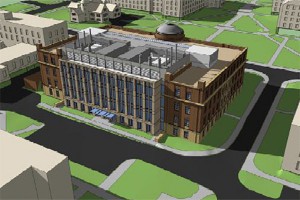 Image: Penn State
Image: Penn State
Steidle Building was originally established in 1929 as the Mineral Industries Building to expand the purview of what was formerly the School of Mines and Metallurgy. The building was later renamed to honor Edward Steidle, a former dean of the College of Earth and Mineral Sciences, and houses the Department of Materials Science and Engineering.
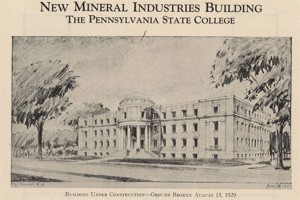
Image: Penn State
Steidle Building was designed by architect Charles Z. Klauder who designed many iconic early Penn State buildings such as Sackett and Henderson buildings, the Nittany Lion Inn and the “new” Old Main. The iconic rotunda and portico, beautifully illustrate Klauder’s Beaux-Arts style.
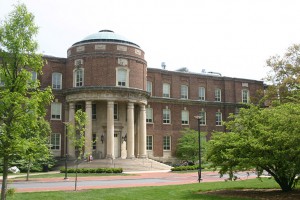
Image: Morgann McAfee
The center wing (1939 addition) of Steidle Building is being demolished as part of a complete top-down, inside-out renovation. New facilities will feature expansive lab space, infrastructure improvements, expanded faculty, staff and student areas, all housed in a floor to ceiling glass atrium.
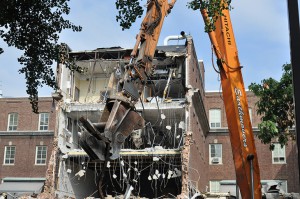
Image: Patricia Craig
“Materials science and engineering is one of the prominent internationally acclaimed programs at Penn State that consistently ranks in the top 10 of materials programs,” said department head Gary Messing. “The Reeds’ generous support will help to ensure that the College of Earth and Mineral Sciences and Penn State will continue to have one of the premier departments in materials.”
Though the Reeds’ gift will not contribute to the “brick and mortar” component of the renovation, their philanthropy will support the academic programs that the facility will house. The equipment in the Paul Herman Reed Thermal Characterization Laboratory will allow researchers to evaluate how material properties change from room temperature to as high as 1,600 degrees centigrade. Such information is essential for selecting materials for specific applications and for designing new manufacturing processes.
Paul Reed served in the U.S. Navy during World War II in the Pacific and later went on to a career in ceramics with New Castle Refractories. He retired as the vice president and general manager of the company. He also served as president of the Pennsylvania Refractories Association and sat on national ceramic and refractory-specific boards. Paul’s late wife, Helen, earned a bachelor’s degree in education from Penn State in 1945. She and Paul attended nearly every Penn State football game from 1964 to 2000. All three of Paul and Helen’s children attended Penn State — Paul D. Reed, Class of 1974 in the College of Liberal Arts and Class of 1976 in the master of business of administration program; Judith Reed Tjiattas, Class of 1978, College of Health and Human Development: and Joel G. Reed, Class of 1982, College of Earth and Mineral Sciences.
Joel Reed is principal at Mereo LLC and is the 2014 president-elect of the Graduates of Earth and Mineral Sciences (GEMS) Alumni Board. Kim is an 1984 computer science alumna and spent most of her career as a staff programmer and software developer at IBM. Joel and Kim live in Breckenridge, Colorado, and have two adult sons, Nick and Grant. The Reeds hope that their gift will inspire other materials science and engineering alumni to leave their own legacy in the Steidle Building.
Penn State’s alumni and friends are invaluable partners in fulfilling the University’s land-grant mission of education, research and service. Private gifts from alumni and friends enrich the experiences of students both in and out of the classroom; expand the research and teaching capacity of our faculty; enhance the University’s ability to recruit and retain top students and faculty; and help to ensure that students from every economic background have access to a Penn State education. The University’s colleges and campuses are now enlisting the support of alumni and friends to advance a range of unit-specific initiatives.
For more information about the Steidle Building renovation, visit http://www.matse.psu.edu/steidle/ online.
CONTACTS:
Patricia L. Craig
Work Phone:
814-863-4663
Marketing and communications, Earth and Mineral Sciences
